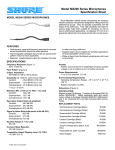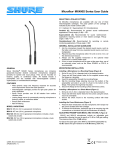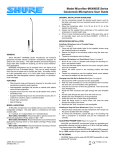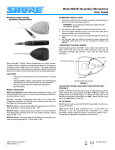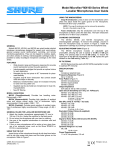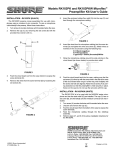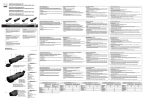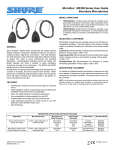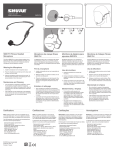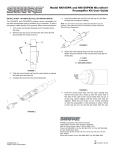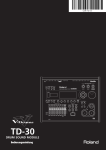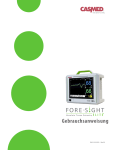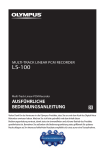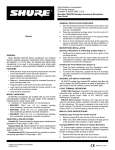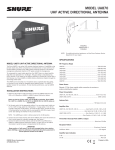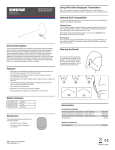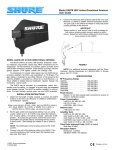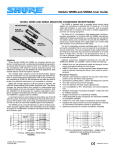Download Model Microflex® MX200 Series Overhead Microphones User Guide
Transcript
Model Microflex® MX200 Series Overhead Microphones User Guide GENERAL Shure Microflex® MX200 Series microphones are miniature electret condenser microphones designed for miking choirs and performance groups. They are typically suspended over the heads of the performers. Their high sensitivity and wide frequency range make them suitable for recording, as well as sound reinforcement applications. An attached 101 mm (4 in.) gooseneck allows them to be easily aimed at the sound source. FEATURES • Wide dynamic range and frequency response for accurate sound reproduction across the audio spectrum • Interchangeable cartridges that provide an optimal polar pattern choice for each application • Supplied stand-mount adapter for portable applications (in-line preamplifier versions only) • White or black finish that blends unobtrusively with most surroundings • New RF filtering VARIATIONS All Microflex microphones are available with any one of three interchangeable cartridges. The polar pattern of the cartridge is indicated by the model number suffix: C = Cardioid, S = Supercardioid, O= Omnidirectional • MX202B/C, S, O: Black mini-condenser microphone; includes cable, in-line preamplifier, and stand adapter. • MX202W/C, S, O: White mini-condenser microphone; includes cable, in-line preamplifier, and stand adapter. • MX202BP/C, S, O: Black mini-condenser microphone; includes cable and plate-mounted preamplifier. Cardioid (C). Recommended for general sound reinforcement applications. Pickup angle (-3 dB) = 130°. Supercardioid (S). Recommended for sound reinforcement applications requiring narrow or more distant coverage. Pickup angle (-3 dB) = 115°. Omnidirectional (O). Recommended for recording or remote monitoring applications. Pickup angle = 360°. GENERAL INSTALLATION GUIDELINES (Figure 1) 1. For choir installations, hang a microphone 0.6 to 0.9 m (2 to 3 ft.) in front of the first row, and 0.6 to 0.9 m (2 to 3 ft.) higher than the heads of the singers in the last row. Aim the microphone at the back row. 2. When miking groups that move or vary in size, use a boom stand and the supplied stand adapter. 3. If four or more microphones will be open at once, an automatic mixer, such as the Shure SCM810 or FP410, is recommended. Set up the automatic mixer so that all overhead microphones gate on simultaneously. MICROPHONE APPLICATION AND SELECTION GUIDE Application Mounting Method Preamplifier Type Color Polar Pattern Model Cable length Sound reinforcement for choirs or theater Stand-mounted or suspended from ceiling In Line In Line In Line In Line Plate Mounted Plate Mounted Plate Mounted Plate Mounted Black White Black White White Black White Black Cardioid Cardioid Supercardioid Supercardioid Cardioid Supercardioid Supercardioid Cardioid MX202B/C MX202W/C MX202B/S MX202W/S MX202WP/C MX202BP/S MX202WP/S MX202BP/C 9 m (30 ft) In Line In Line Black White Black White Omnidirectional Omnidirectional Omnidirectional Omnidirectional MX202B/N with R183B MX202W/N with R183W MX202BP/N with R183B MX202BP/N with R183W 9 m (30 ft) Suspended from ceiling Ambience recording or remote monitoring of speech and vocals Stand-mounted or suspended from ceiling MICROPHONE INSTALLATION (Figure 2) The microphone is most stable when the gooseneck is bent into a “lazy S” shape as shown in Figure 2. Use the supplied hanging clip and heavy thread or monofilament fishing line to suspend the microphone at a specific location. ©2006, Shure Incorporated 27J2836 (Rev. 1) INSTALLING THE FOAM WINDSCREEN (Figure 3) 1. Press the foam windscreen onto the microphone until it snaps into the groove located behind the cartridge. 2. To remove the windscreen, spread the gap in its mounting ring with a screwdriver or thumbnail and pull the windscreen off. Printed in U.S.A. PREAMPLIFIER INSTALLATION Equivalent Output Noise (A-weighted) Cardioid: 28.0 dB SPL Supercardioid: 26.5 dB SPL Omnidirectional: 20.5 dB SPL Signal to Noise Ratio (referenced at 94 dB SPL) Cardioid: 66.0 dB Supercardioid: 67.5 dB Omnidirectional: 73.5 dB Dynamic Range at 1 kΩ Load 96.2 dB Plate-Mount Preamplifier Input Connections 1. Detach the preamplifier housing by removing the two Phillips head screws from the back of the housing. 2. Remove the material from the hole in the center of the cover plate or the center of the preamplifier housing. 3. Cut the cable to the desired hanging length, allowing for a 76 to 101 mm (3 to 4 in.) service loop. 4. Clamp the strain relief around the cable and insert the strain relief into the hole. 5. Connect the cable leads to the terminal block (B = Black, R = Red, S = Shield). 100 dB at 0 gain Common Mode Rejection 45.0 dB minimum Preamplifier Output Clipping Level (1% THD) -6.0 dBV (0.5 V) Plate-Mount Preamplifier Output Cable Connections 1. Using professional-quality, two-conductor, shielded microphone cable, thread the output cable from the outside of the preamplifier through the hole with the black bushing. 2. Connect cable to pins as follows: Pin 2 = +, Pin 3 = –, Shield = S. 3. Reattach the preamplifier housing. -12 dBV at 0 gain Polarity Positive sound pressure on diaphragm produces positive voltage on pin 2 relative to pin 3 of output connector. Power Requirements 11 to 52 Vdc phantom, 2.0 mA Environmental Requirements Operating Temperature Range: -18° C to 57° C (0° F to 135° F) Relative Humidity: 0 to 95% Dimensions (Figure 6) CEILING TILE INSTALLATION (Figure 4) Remove: Plate-Mount Preamp Connection 1. Drill a 1/2” hole into the ceiling tile. CAUTION: To avoid damaging the tile, use a 1/2" augur bit and drill by hand or very slowly with a variable-speed drill. 2. Unplug the mini 4-pin connector from the preamp and feed the cable through the hole. 3. Place the rubber grommet, tip down, over the cable and position it to suspend the microphone at the appropriate height. 4. Fit the grommet securely into the hole. For 5/8" ceiling tile, use the supplied washer. 5. Reconnect the Preamp. CERTIFICATION Eligible to bear CE Marking. Conforms to European EMC Directive 89/336/EEC. Meets applicable tests and performance criteria in European Standard EN55103 (1996) parts 1 and 2, for residential (E1) and light industrial (E2) environments. NOTE: For technical data by fax, phone 1-800-516-2525 and follow the recorded instructions. For additional technical assistance, phone Shure at (847) 600-2000. In Europe, phone 49-7131-72140. INSTALLING THE IN-LINE PREAMPLIFIER (Figure 4) Use the two supplied mounting clamps to hold the preamplifier in place on a wall or ceiling. Shure, the Shure logo, and Microflex are registered trademarks of Shure Incorporated. ADJUSTING PREAMP GAIN: MX202B AND MX202W ONLY (Figure 5) MX202B and MX202W microphones include an adjustable gain preamplifier, allowing the user to specify a 12 dB or 0 dB gain setting. The preamp ships at 12 dB setting. To reduce the signal gain at the MX202B and M202W preamplifier by 12dB, replace the gain resistors to the 0dB setting (Table 5A). FURNISHED ACCESSORIES Snap-Fit Windscreen Black (1 furnished, 4 in replacement kit) . . . . . . RK183WS White (1). . . . . . . . . . . . . . . . . . . . . . . . . . . . . . . . 95B2064 Preamplifier Kit, Plate Mounted, White (MX202BP & MX202WP) . . . . . . . . . . . . . . . . . . .RK202PK Stand Adaptor (MX202B and MX202W) . . . . . . . . . 65B1752 RF FILTERING MX200 Series must be used with RK100PK or RK202PK preamplifier, in order to optimize RF immunity. OPTIONAL ACCESSORIES Desk Stand . . . . . . . . . . . . . . . . . . . . . . . . . . . . . . . . A202BB SPECIFICATIONS Frequency Response (Figure 7) 50 to 17,000 Hz Polar Pattern (Figure 8) Output Impedance 180 Ω actual (EIA rated at 150 Ω) Sensitivity (At 1,000 Hz, open circuit voltage*) Cardioid: -35.0 dBV/Pa (17.8 mV) Supercardioid: -33.5 dBV/Pa (21.1 mV) Omnidirectional: -27.5 dBV/Pa (42.2 mV) REPLACEMENT PARTS In-Line Preamplifier (Black). . . . . . . . . . . . . . . . . . .RK100PK In-Line Preamplifier (White) . . . . . . . . . . . . . . . . RK100PKW Omnidirectional Cartridge (Black) . . . . . . . . . . R183B (White) . . . . . . . . . R183W Supercardioid Cartridge (Black) . . . . . . . . . . R184B (White) . . . . . . . . . R184W Cardioid Cartridge (Black) . . . . . . . . . . R185B (White) . . . . . . . . . R185W Strain Relief (MX202BP & MX202WP) . . . . . . . . . . . 80A479 Clamp (MX202B & MX202WP) . . . . . . . . . . . . . . . . . 80A476 Hang Clip . . . . . . . . . . . . . . . . . . . . . . . . . . . . . . . . . 80B489 All values -12 dB at 0 gain *1 Pascal = 94 dB SPL Maximum SPL (1 kHz at 1% THD, 1 kΩ load) Cardioid: 124.2 dB Supercardioid: 122.7 dB Omnidirectional: 116.7 dB All values +6 dB at 0 gain 2 MICROPHONE SUSPENDU MICROFLEX® SÉRIE MX200 GUIDE DE L'UTILISATEUR • MX202B/C, S, O : Mini microphone électrostatique noir avec câble, préampli et adaptateur de pied. • MX202W/C, S, O : Mini microphone électrostatique blanc avec câble, préampli et adaptateur de pied. • MX202BP/C, S, O : Mini microphone électrostatique noir avec câble et préampli monté sur plaque. • MX202WP/C, S, O : Mini microphone électrostatique blanc avec câble et préampli monté sur plaque. Cardioïde (C). Recommandé pour les applications de sonorisation générale. Angle de captage (-3 dB) = 130°. Cardioïde (C). Recommandé pour les applications de sonorisation générale. Angle de captage (-3 dB) = 130°. Supercardioïde (S). Recommandé pour les applications de sonorisation exigeant un captage plus étroit ou à plus grande distance. Angle de captage (-3 dB) = 115°. Omnidirectionnel (O). Recommandé pour l'enregistrement ou le captage à distance. Angle de captage = 360°. GÉNÉRALITÉS Les Shure Microflex® série MX200 sont des microphones électrostatiques conçus pour la prise de son de choeurs et groupes vocaux. Ils sont en général suspendus au-dessus de la tête des artistes. Leur haute sensibilité et large gamme de fréquence permettent de les utiliser pour les enregistrements et la sonorisation de scène. Un col de cygne intégré de 10 cm permet de les orienter facilement vers la source sonore. AVANTAGES • Large gamme dynamique et courbe de réponse pour une reproduction précise du son sur tout le spectre audio • Capsules interchangeables permettant une courbe de directivité optimale pour chaque application • Adaptateur de pied inclus permettant l'utilisation sur un pied de micro (versions à préampli en ligne seulement) • Fini noir ou blanc assurant la discrétion dans la plupart des décors • Nouveau filtrage RF DIRECTIVES GÉNÉRALES POUR L'INSTALLATION (Figure 1) 1. Pour la prise de son des choeurs, suspendre un microphone à 60 à 90 cm au-dessus du premier rang et à 60 à 90 cm au-dessus de la tête des choristes du dernier rang. Orienter le microphone vers le dernier rang. 2. Pour la prise de son de groupes mobiles ou variables en nombre, utiliser une girafe et l'adaptateur de pied fourni. 3. Lorsque quatre microphones ou plus doivent être ouverts simultanément l'usage d'une table de mélange automatique, telle que la Shure SCM810 ou FP410 est recommandé. Régler la table de mélange de façon à ce que tous les microphones suspendus soient activés simultanément. VARIANTES Tous les microphones Microflex sont fournis avec l'une des trois capsules interchangeables. La courbe de directivité de la capsule utilisée dans un micro particulier est indiquée par le suffixe du numéro de modèle : C = Cardioïde, S = Supercardioïde, O= Omnidirectionnelle GUIDE DE SÉLECTION ET D'APPLICATION DES MICROPHONES Application Méthode de montage Micros à préampli Couleur Courbe de directivité Modèle Longueur du câble Sonorisation de choeurs ou de théâtre Sur pied ou suspendu au plafond En ligne En ligne En ligne En ligne Monté sur plaque Monté sur plaque Monté sur plaque Monté sur plaque Noir Blanc Noir Blanc Blanc Noir Blanc Noir Cardioïde Cardioïde Supercardioïde Supercardioïde Cardioïde Supercardioïde Supercardioïde Cardioïde MX202B/C MX202W/C MX202B/S MX202W/S MX202WP/C MX202BP/S MX202WP/S MX202BP/C 9m En ligne En ligne Noir Blanc Noir Blanc Omnidirectionnelle Omnidirectionnelle Omnidirectionnelle Omnidirectionnelle MX202B/N avec R183B MX202W/N avec R183W MX202BP/N avec R183B MX202BP/N avec R183W 9m Suspendu au plafond Enregistrement Sur pied ou suspendu d'ambiance ou au plafond contrôle à distance de la voix INSTALLATION DU COUPE-VENT EN MOUSSE (Figure 3) 1. Enfoncer le coupe-vent en mousse sur le microphone jusqu'à ce qu'il s'encliquette dans la gorge se trouvant derrière la capsule. 2. Pour le retirer, écarter les extrémités de la bague de montage avec un tournevis ou une punaise et le dégager du micro. INSTALLATION DU MICROPHONE (Figure 2) La meilleure stabilité du micro est obtenue avec le col de cygne courbé en forme de "S" allongé, comme illustré à la figure 2. Suspendre le microphone à l'endroit désiré au moyen du clip fourni et d'un cordon ou d'un fil de pêche monofilament solide. 3 INSTALLATION DU PRÉAMPLI NPA maximum (1 kHz avec DHT de 1 %, charge de 1 KΩ) Cardioïde : 124,2 dB Supercardioïde : 122,7 dB Omnidirectionnel : 116,7 dB Branchement d'entrée du préampli monté sur plaque 1. Retirer les deux vis Phillips au dos du boîtier du préampli pour le détacher. 2. Ouvrir le trou pré-perforé du centre du couvercle ou du boîtier du préampli. 3. Couper le câble à la longueur voulue en prévoyant 8 à 10 cm supplémentaire pour former une boucle. 4. Refermer le soulagement de traction sur le câble et l'insérer dans le trou. 5. Brancher les fils du câble sur le bornier (B = noir, R = rouge, S = Blindage). Branchement du câble de sortie du préampli monté sur plaque 1. Utiliser un câble de microphone blindé à deux conducteurs, de qualité professionnelle. Insérer le câble de l'extérieur du préampli, dans le trou muni d'une bague noire. 2. Brancher le câble comme suit : Broche 2 = +, Broche 3 = –, Blindage = S. 3. Remonter le boîtier du préampli. +6 dB à 0 gain Bruit de sortie équivalent (pondération en A) Cardioïde : 28,0 dB NPA Supercardioïde : 26,5 dB NPA Omnidirectionnel : 20,5 dB NPA Rapport signal/bruit (mesuré avec une pression acoustique de 94 dB) Cardioïde : 66,0 dB Supercardioïde : 67,5 dB Omnidirectionnel : 73,5 dB Gamme dynamique avec charge de 1 kΩ 96,2 dB 100,0 dB à 0 gain Rejet en mode commun 45,0 dB au minimum Niveau d'écrêtage de sortie préampli (1 % DHT) -6,0 dBV (0,5 V) -12,0 dBV à 0 gain Polarité Une pression acoustique positive sur le diaphragme produit une tension positive sur la broche 2 par rapport à la broche 3 du connecteur de sortie. Alimentation 11 à 52 V c.c. duplex, 2,0 mA Environnement Plage de températures de fonctionnement : -18 à 57°C Humidité relative : 0 à 95% Dimensions (Figure 6) INSTALLATION SUR CARREAU DE PLAFOND : Enlever : Branchement du préampli monté sur plaque (Figure 4) 1. Percer un trou de ½ po dans le carreau de plafond. ATTENTION : Pour éviter d'endommager le carreau, utiliser une mèche hélicoïdale de ½ po et percer à la main ou très lentement avec une perceuse à vitesse variable. 2. Débrancher le connecteur miniature à 4 broches du préampli et faire passer le câble par le trou. 3. Placer l'oeillet en caoutchouc, embout vers le bas, sur le câble et le placer de façon à pouvoir suspendre le microphone à la hauteur appropriée. 4. Bien ajuster l'œillet dans le trou. Pour un carreau de plafond de 5/8 po, utiliser la rondelle fournie. 5. Rebrancher le préampli. HOMOLOGATION Autorisé à porter la marque CE. Conforme à la directive CEM européenne 89/336/CEE. Conforme aux critères applicables de test et de performances de la norme européenne EN 55103 (1996) parties 1 et 2 pour les environnements résidentiels (E1) et d'industrie légère (E2). REMARQUE : Pour toute information technique par télécopie, composer le 1-800-516-2525 et suivre les instructions de l'enregistrement. Pour toute assistance technique supplémentaire, appeler Shure au (847) 600-2000. En Europe, appeler le 49-7131-72140. INSTALLATION DU PRÉAMPLI EN LIGNE (Figure 4) Fixer le microphone sur un mur ou un plafond à l'aide des deux pinces de montage fournies. RÉGLAGE DU GAIN DU PRÉAMPLI : MX202B ET MX202W SEULEMENT (Figure 5) Les microphones MX202B et MX202W comprennent un préamplificateur à gain réglable, ce qui permet à l'utilisateur de choisir un réglage du gain de 12 dB ou de 0 dB. Pour réduire le gain aux préamplis MX202B et MX202W de 12 dB, remettre les résistances de gain au réglage 0 dB, (Tableau 5A). ACCESSOIRES FOURNIS Kit de préampli, monte sur plaque, blanche (MX202BP et MX202WP) . . . . . . . . . . . . . . . . . .RK202PK Coupe-vent encliquetable (1 fourni) 4 dans le kit de pièces de rechange, noir. . . . . . RK183WS Blanc (1). . . . . . . . . . . . . . . . . . . . . . . . . . . . . . . . 95B2064 Adaptateur de pied (MX202B et MX202W). . . . . . . 65B1752 FILTRAGE RF : La série MX200 doit être utilisée avec le préampli RK100PK ou un RK202PK de manière à optimiser l'immunité RF. CARACTÉRISTIQUES ACCESSOIRES EN OPTION Socle de pupitre . . . . . . . . . . . . . . . . . . . . . . . . . . . . A202BB Courbe de réponse (Figure 7) 50 à 17 000 Hz Courbe de directivité (Figure 8) Impédance de sortie 180 Ω réels (EIA nominale 150 Ω) Sensibilité en circuit ouvert (à 1000 Hz réf. 1V/Pascal*) Cardioïde : -35,0 dBV/Pa (17,8 mV) Supercardioïde : -33,5 dBV/Pa (21,1 mV) Omnidirectionnel : -27,5 dBV/Pa (42,2 mV) PIÈCES DE RECHANGE Capsule omnidirectionnelle Capsule Supercardioïde Capsule cardioïde (noire) . . . . . . . . . . R183B (blanche) . . . . . . . R183W (noire) . . . . . . . . . . R184B (blanche) . . . . . . . R184W (noire) . . . . . . . . . . R185B (blanche) . . . . . . . R185W Soulagement de traction (MX202BP et MX202WP) . . . . . . . . . . . . . . . . . . . 80A479 Attache (MX202B et MX202W) . . . . . . . . . . . . . . . . . 80A476 Pince de suspension . . . . . . . . . . . . . . . . . . . . . . . . . 80B489 Préampli en ligne (noire) . . . . . . . . . . . . . . . . . . . . .RK100PK Préampli en ligne (blanc) . . . . . . . . . . . . . . . . . . RK100PKW -12 dB à 0 gain *1 Pascal = 94 dB NPA 4 GEBRAUCHSANLEITUNG FÜR MICROFLEX® OVERHEADMIKROFONE DER REIHE MX200 • MX202B/C, S, O: Schwarzes Mini-Kondensatormikrofon, einschließlich Kabel, In-line-Vorverstärker und Stativadapter. • MX202W/C, S, O: Weißes Mini-Kondensatormikrofon, einschließlich Kabel, In-line-Vorverstärker und Stativadapter. • MX202BP/C, S, O: Schwarzes Mini-Kondensatormikrofon, einschließlich Kabel und Vorverstärker zum Wandeinbau. • MX202WP/C, S, O: Weißes Mini-Kondensatormikrofon, einschließlich Kabel und Vorverstärker zum Wandeinbau. Niere (C). Für allgemeine Mikrofonanwendungen empfohlen. Ansprechwinkel (-3 dB) = 130°. Superniere (S). Für Mikrofonanwendungen empfohlen, die eine engere oder weiter entfernte Signal-Abdeckung, die eine engere oder weiter entfernte Abdeckung erfordern. Ansprechwinkel (-3 dB) = 115°. Kugel (O). Für Aufzeichnungs- oder Fernüberwachungsanwendungen empfohlen. Ansprechwinkel = 360°. ALLGEMEINES Shure Microflex® Mikrofone der Reihe MX200 sind Mini-Elektretkondensatormikrofone, die zur Aufnahme von Chören und aufführenden Gruppen vorgesehen sind. Üblicherweise hängen sie über den Köpfen der Aufführenden herab. Durch ihre hohe Empfindlichkeit und den breiten Frequenzbereich eignen sie sich zu Aufzeichnungszwecken sowie für Beschallungsanwendungen. Ein daran befestigter 10 cm langer Schwanenhals ermöglicht ihre einfache Ausrichtung auf die Schallquelle. MERKMALE • Hoher Dynamikbereich und breiter Frequenzgang für genaue Tonwiedergabe über das gesamte Tonfrequenzspektrum hinweg • Austauschbare Kapseln, die eine optimale Richtcharakteristik für jeden Verwendungszweck ermöglichen • Mitgelieferter Adapter zur Stativbefestigung für tragbare Anwendungen (nur bei In-line-Vorverstärkerausführungen) • Weiße oder schwarze Ausführung, die sich unauffällig in die meisten Umgebungen einfügt • Neues Design zur HF Filterung ALLGEMEINE INSTALLATIONSRICHTLINIEN (Abbildung 1) 1. Für Choraufnahmen ein Mikrofon knapp einen Meter vor der ersten Reihe und knapp 1 Meter höher als die Köpfe der Sänger in der letzten Reihe aufhängen. Das Mikrofon auf die hintere Reihe ausrichten. 2. Bei Aufnahme von Gruppen, die sich bewegen oder veränderlich groß sind, einen Mikrofonständer und den mitgelieferten Adapter verwenden. 3. Wenn vier oder mehr Mikrofone gleichzeitig verwendet werden sollen, ist der Einsatz eines Automatikmischers, wie z.B. Shure SCM810 oder FP410, zu empfehlen. Den Automatikmischer so einstellen, daß alle Overhead-Mikrofone gleichzeitig öffnen. VARIANTEN Alle Microflex-Mikrofone sind mit einer von drei austauschbaren Kapseln lieferbar. Die Richtcharaktersitik der Kapsel wird durch das Kürzel am Ende der Modellnummer angegeben. C = Niere, S = Superniere, O= Kugel ANLEITUNG ZUR MIKROFONVERWENDUNG UND -AUSWAHL Verwendungszweck Installationsverfahren Vorverstärkertyp Farbe Polarmuster Modell Kabellänge Tonverstärkung für Chor oder Theater Auf einem Stativ montiert oder von der Decke hängend In-line In-line In-line In-line Plattenmontiert Plattenmontiert Plattenmontiert Plattenmontiert Schwarz Weiß Schwarz Weiß Weiß Schwarz Weiß Schwarz Kardioid Kardioid Superkardioid Superkardioid Kardioid Superkardioid Superkardioid Kardioid MX202B/C MX202W/C MX202B/S MX202W/S MX202WP/C MX202BP/S MX202WP/S MX202BP/C 9m In-line In-line Schwarz Weiß Schwarz Weiß Alle Richtungen Alle Richtungen Alle Richtungen Alle Richtungen MX202B/N mit R183B MX202W/N mit R183W MX202BP/N mit R183B MX202BP/N mit R183W 9m Von der Decke hängend Umgebungsaufzeichnung Auf einem Stativ montiert oder Fernüberwachung oder von der Decke hängend von Sprache und Gesang Von der Decke hängend INSTALLATION DES VORVERSTÄRKERS Installation des Mikrofons (Abbildung 2) Das Mikrofon ist am stabilsten, wenn der Schwanenhals in die Form eines “langgezogenen S” gebogen wird, wie in Abbildung 2 dargestellt. Das Mikrofon mit Hilfe der mitgelieferten Hängeklammer und mit starkem Faden oder einer Angelschnur an einer bestimmten Stelle aufhängen. EINGANGSANSCHLÜSSE DES VORVERSTÄRKERS ZUM WANDEINBAU 1. Das Vorverstärkergehäuse abnehmen, indem die beiden Kreuzschlitz-Kopfschrauben aus der Rückseite des Gehäuses herausgeschraubt werden. 2. Das Material aus der Öffnung in der Mitte der Abdeckplatte oder aus der Mitte des Vorverstärkergehäuses entfernen. 3. Das Kabel auf die gewünschte Länge zuschneiden und dabei eine 8-10 cm lange Reserve berücksichtigen. 4. Die Zugentlastung um das Kabel klemmen und in die Öffnung einführen. 5. Die Kabelleitungen an die Klemmleiste anschließen (B = Schwarz, R = Rot, S = Abschirmung). ANBRINGUNG DES SCHAUMSTOFF-WINDSCHUTZES (Abbildung 3) 1. Den Schaumstoff-Windschutz auf das Mikrofon drücken, bis er in die Rille hinter der Kapsel einrastet. 2. Zum Abnehmen des Windschutzes den Spalt in seinem Befestigungsring mit einem Schraubenzieher oder Daumennagel auseinander spreizen und den Windschutz abziehen. 5 Rauschabstand (bezogen auf 94 dB Schalldruckpegel) Niere: 66,0 dB Superniere: 67,5 dB Kugel: 73,5 dB Dynamikbereich bei 1 kΩ Belastung 96,2 dB AUSGANGSKABELANSCHLÜSSE DES VORVERSTÄRKERS ZUM WANDEINBAU 1. Hochwertiges, zweipoliges, abgeschirmtes Mikrofonkabel verwenden und das Ausgangskabel von der Außenseite des Vorverstärkers durch die Öffnung mit der schwarzen Hülse führen. 2. Das Kabel wie folgt mit den Pins verbinden: Pin 2 = +, Pin 3 = –, Abschirmung = S 3. Das Vorverstärkergehäuse wieder anbringen. 100,0 dB bei 0 dB Verstärkungsfaktor Gleichtaktunterdrückung mindestens 45,0 dB Maximaler Ausgangspegel des Vorverstärkers (1% Klirrfaktor) -6,0 dBV (0,5 V) MONTAGE AN DECKENPLATTEN (Abbildung 4): 1. Ein Loch mit ½ Zoll (13 mm) Durchmesser in die Deckenplatte bohren. VORSICHT: Einen ½-Zoll (13 mm)-Bohrer verwenden und von Hand oder sehr langsam mit einer Bohrmaschine mit stufenloser Drehzahl bohren, damit die Platte nicht beschädigt wird. 2. Den 4-Pin-Ministecker aus dem Vorverstärker ziehen und das Kabel durch das Loch führen. 3. Die Gummitülle mit der Spitze nach unten auf das Kabel setzen und so positionieren, dass das Mikrofon in der richtigen Höhe aufgehängt ist. 4. Die Tülle fest in das Loch einpassen. Bei Deckenplatten mit einer Stärke von 5/8 Zoll (16 mm) die mitgelieferte Unterlegscheibe verwenden. 5. Den Vorverstärker wieder anschließen. -12,0 dBV bei 0 dB Verstärkungsfaktor Polarität Positiver Schalldruck an der Membran erzeugt positive Spannung an an Pin 2 in bezug auf Pin 3 des Ausgangssteckers. Leistungsbedarf 11 bis 52 V Phantom-Spannung, 2,0 mA Umgebungsbedingungen Betriebstemperaturbereich: -18 bis 57°C Relative Feuchtigkeit: 0 to 95 % Abmessungen (Abbildung 6) ZERTIFIZIERUNG Zur CE-Kennzeichnung berechtigt. Entspricht der EU-Richtlinie über elektromagnetische Verträglichkeit 89/336/EEC. Erfüllt die Prüfungs- und Leistungskriterien der europäischen Norm EN 55103 (1996) Teil 1 und 2 für Wohngebiete (E1) und Leichtindustriegebiete (E2). INSTALLATION DES IN-LINE-VORVERSTÄRKERS (Abbildung 4) Den Vorverstärker mit Hilfe der beiden mitgelieferten Montageschellen an einer Wand oder Decke befestigen. HINWEIS: Faxabruf technischer Daten unter der Rufnummer 1–800–516–2525 (nur innerhalb der USA), dabei Anleitungen des Anrufbeantworters befolgen. Weitere technische Unterstützung wird von Shure unter der Rufnummer +1 (847) 600–2000 geleistet. In Europa bitte +49 (7131) 72140 anrufen. EINSTELLUNG DES VERSTÄRKUNGSFAKTORS AM VORVERSTÄRKER: NUR MX202B UND MX202W (ABBILDUNG 5) MX202B und MX202W Mikrofone enthalten einen Vorverstärker mit Verstärkungseinstellung, der dem Benutzer ermöglicht, eine 12-dB- oder 0-dB-Verstärkungseinstellung zu wählen. Um die Signalverstärkung am Vorverstärker MX202B und MX202W um 12 dB zu verringern, die Widerstandsbauteile auf die 0 dB Verstärkung ändern (entsprechend Tabelle 5A). HF-FILTERUNG: Zur Optimierung der HF-Störfestigkeit muss die die Modellreihe MX200 mit dem Vorverstärker RK100PK oder RK202PK verwendet werden. MITGELIFERTES ZUBEHÖR Ersatzvorverstärker zum Wandeinbau, weiß (MX202BP und MX202WP) . . . . . . . . . . . . . . . . .RK202PK Einrastender Schaumstoff-Windschutz Schwarz (1 x mitgeliefert, 4 x in Ersatzpackung) . RK183WS Weiß (1) . . . . . . . . . . . . . . . . . . . . . . . . . . . . . . . . 95B2064 Stativadapter (MX202B und MX202W) . . . . . . . . . . 65B1752 TECHNISCHE DATEN Frequenzgang (Abbildung 7) 50 bis 17.000 Hz Richtcharaktersitik (Abbildung 8) Ausgangsimpedanz Ist-Wert: 180 Ω (EIA-Nennwert: 150 Ω) Leerlaufempfindlichkeit (bei 1 kHz, bezogen auf 1 V/Pascal*) Niere: -35,0 dBV/Pa (17,8 mV) Superniere: -33,5 dBV/Pa (21,1 mV) Kugel: -27,5 dBV/Pa (42,2 mV) SONDERZUBEHÖR Tischstativ . . . . . . . . . . . . . . . . . . . . . . . . . . . . . . . . . A202BB ERSATZTEILE Kugelkapsel (Schwarz). . . . . . . . R183B (Weiß) . . . . . . . . . R183W Supernierenkapsel Schwarz) . . . . . . . . R184B (Weiß) . . . . . . . . . R184W Nierenkapsel (Schwarz). . . . . . . . R185B (Weiß) . . . . . . . . . R185W Zugentlastung (MX202BP und MX202WP). . . . . . . . 87A479 Klemme (MX202B und MX202W) . . . . . . . . . . . . . . . 80A476 Hängeklammer . . . . . . . . . . . . . . . . . . . . . . . . . . . . . 80B489 In-Line-Vorverstärker (Schwarz) . . . . . . . . . . . . . . .RK100PK In-Line-Vorverstärker (Weiß). . . . . . . . . . . . . . . . RK100PKW -12 dB bei to 0 dB Verstärkungsfaktor *1 Pascal = 94 dB Schalldruckpegel Maximaler Schalldruckpegel (1 kHz bei 1 % Klirrfaktor, 1 kΩ Last) Niere: 124,2 dB Superniere: 122,7 dB Kugel: 116,7 dB +6 dB bei 0 dB Verstärkungsfaktor Äquivalentes Ausgangsrauschen (mit A-Gewichtung) Niere: 28,0 dB Schalldruckpegel Superniere: 26.5 dB Schalldruckpegel Kugel: 20,5 dB Schalldruckpegel 6 GUIA DEL USUARIO DEL MICROFONO SUSPENDIDO MICROFLEX® SERIE MX200 • MX202B/C, S, O: Micrófono de condensador en miniatura negro; incluye cable, preamplificador en línea y adaptador de pedestal. • MX202W/C, S, O: Micrófono de condensador en miniatura blanco; incluye cable, preamplificador en línea y adaptador de pedestal. • MX202BP/C, S, O: Micrófono de condensador en miniatura negro; incluye cable y preamplificador montado en placa. • MX202WP/C, S, O: Micrófono de condensador en miniatura blanco; incluye cable y preamplificador montado en placa. Cardioide (C). Se recomienda para aplicaciones generales de refuerzo de sonido. Angulo de captación (nivel de -3 dB) = 130°. Supercardioide (S). Se recomienda para aplicaciones de refuerzo de sonido en las cuales la zona de cobertura es más estrecha o se requiere un alcance mayor. Angulo de captación (nivel de -3 dB) = 115°. Omnidireccional (O). Se recomienda para aplicaciones de grabación y de monitoreo remoto de sonido. Angulo de captación = 360°. GENERALIDADES Los micrófonos Shure Microflex® serie MX200 son micrófonos de condensador de electreto en miniatura diseñados para la captación de coros y grupos musicales. Típicamente se suspenden por encima de las cabezas de los ejecutores. Su alta sensibilidad y amplia gama de frecuencias los hacen útiles para situaciones de grabación o de refuerzo de sonido. Un cuello de cisne de 10 cm (4 pulg) permite orientarlos fácilmente hacia la fuente sonora. CARACTERISTICAS • Gama dinámica y respuesta de frecuencia amplias para una reproducción precisa del sonido en todo el espectro audible • Cartuchos intercambiables que permiten elegir el patrón polar óptimo para cada aplicación • Adaptador para pedestal para uso con equipos portátiles (sólo modelos con preamplificador en línea) • Acabado en blanco o en negro que se combina discretamente con el entorno • Nuevo sistema de filtro de radiofrecuencia GUIA GENERAL DE INSTALACION (Figura 1) 1. Para captar las voces de un coro, suspenda un micrófono 0,61 m delante de la primera fila de cantantes y 0,6-1 m por encima de las cabezas de la última fila de cantantes. Oriente el micrófono hacia la última fila. 2. Para captar grupos que se moverán o que variarán de tamaño, utilice un soporte tipo jirafa y el adaptador de pedestal incluido. 3. Si cuatro o más micrófonos estarán activos simultáneamente, se recomienda usar una consola mezcladora automática tal como la SCM810 ó la FP410 de Shure. Configure la consola mezcladora automática de manera que todos los micrófonos suspendidos se activen simultáneament VARIACIONES Todos los micrófonos Microflex se ofrecen con uno de tres cartuchos intercambiables. El patrón polar de captación del cartucho se designa por el sufijo que tiene en su número de modelo: C = Cardioide, S = Supercardioide, O = Omnidireccional GUIA PARA LA SELECCION Y USO DE MICROFONOS Uso Método de montaje Tipo de preamplificador Color Patrón polar Modelo Largo de cable Refuerzo de sonido para coros o presentaciones teatrales Montados en jirafas o suspendidos del techo En línea En línea En línea En línea Montado en Placa Montado en Placa Montado en Placa Montado en Placa Negro Blanco Negro Blanco Blanco Negro Blanco Negro Cardioide Cardioide Supercardioide Supercardioide Cardioide Supercardioide Supercardioide Cardioide MX202B/C MX202W/C MX202B/S MX202W/S MX202WP/C MX202BP/S MX202WP/S MX202BP/C 9 m (30 pies) En línea En línea Negro Blanco Negro Blanco Omnidireccional MX202B/N con R183B Omnidireccional MX202W/N con R183W Omnidireccional MX202BP/N con R183B Omnidireccional MX202BP/N con R183W Grabación de sonido ambiental o monitoreo remoto de voces Suspendidos del techo Montados en jirafas o suspendidos del techo INSTALACION DEL MICROFONO (Figura 2) El micrófono queda más estable cuando el cuello de cisne se dobla en forma de una “S” suave, como se muestra en la Figura 3. Utilice la presilla de colgado incluida y un hilo grueso o hilo de pescar de monofilamento para suspender el micrófono en el punto deseado. 9 m (30 pies) CONEXIÓN DEL PREAMPLIFICADOR Conexión del cable de entrada del preamplificador de montaje en placa 1. Suelte la caja del preamplificador sacando los dos tornillos Phillips de su parte trasera. 2. Quite el material del agujero en el centro de la cubierta o en el centro de la caja del preamplificador. 3. Corte el cable al largo deseado, dejando un largo adicional de 8-10 cm para mantenimiento. 4. Instale el amortiguador de esfuerzos en el cable e insértelo en el agujero. 5. Conecte los conductores del cable al bloque de bornes (B = Negro, R = Rojo, S = Blindaje). INSTALACION DE LA PANTALLA DE ESPUMA (Figura 3) 1. Deslice la pantalla de espuma sobre el micrófono hasta que se enganche en la ranura ubicada detrás del cartucho del mismo. 2. Para quitar la pantalla, abra la separación de su anillo de montaje con un destornillador o la uña y tírela hasta quitarla. 7 Gama dinámica con carga de 1 kΩ 96,2 dB Conexión del cable de salida del preamplificador de montaje en placa 1. Utilice cable para micrófonos de calidad profesional, de dos conductores con blindaje, y pase el cable de salida desde el exterior del preamplificador a través del agujero con el buje negro. 2. Conecte el cable a las clavijas de la manera siguiente: Clavija 2 = (+); Clavija 3 = (-); Blindaje = S. 3. Vuelva a instalar la caja del preamplificador. 100,0 dB con ganancia en 0 Rechazo en modo común 45,0 dB mínimo Nivel de limitación de salida del preamplificador (1% THD) -6,0 dBV (0,5 V) -12,0 dBV con ganancia en 0 Polaridad Una presión positiva en el diafragma del micrófono produce un voltaje positivo en la clavija 2 con respecto a la clavija 3 del conector de salida. Requisitos de alimentación 11 a 52 VCC de potencia fantasma nominal; 2,0 mA Requisitos de entorno Gama de temperatura de funcionamiento: -18° a 57°C (0° a 135°F) Humedad relativa: 0 a 95% Dimensiones (Figura 6) INSTALACIÓN EN CIELORRASO: (Figura 4) 1. Perfore un agujero de 1/2 pulg en la losa del cielorraso. PRECAUCION: Para evitar dañar la losa, use una broca tipo sinfín de 1/2 pulg y perfore de forma manual o muy lentamente con un taladro de velocidad variable. 2. Desenchufe el conector miniatura de 4 clavijas del preamplificador y pase el cable por el agujero. 3. Coloque el ojal de caucho, con la punta hacia abajo, sobre el cable y ubíquelo de manera que sostenga el micrófono en la altura correcta. 4. Encaje el ojal de caucho firmemente en el agujero. Para una losa de 5/8 pulg, use la arandela suministrada 5. Vuelva a conectar el preamplificador INSTALACION DEL PREAMPLIFICADOR EN LINEA (Figura 4) Utilice las dos abrazaderas de montaje incluidas para fijar el preamplificador a una pared o al techo. CERTIFICACIONES Califica para llevar las marcas CE. Cumple la directiva europea 89/ 336/EEC de compatibilidad electromagnética. Se ajusta a los criterios correspondientes de verificación y funcionamiento establecidos en la norma europea EN 55103 (1996), partes 1 y 2, para zonas residenciales (E1) y zonas de industria ligera (E2). NOTA: Para obtener información técnica vía Fax, llame al 1-800-516-2525 y siga las instrucciones dadas en la grabación. Para recibir soporte técnico adicional, llame a Shure al teléfono (847) 600-2000. En Europa, llame al 49-7131-72140. AJUSTE DE LA GANANCIA DEL PREAMPLIFICADOR: MX202B Y MX202W SOLAMENTE (Figura 5) Los micrófonos MX202B y MX202W incluyen un preamplificador con ganancia ajustable que permite al usuario especificar una ganancia de 12 ó 0 dB. Para reducir la ganancia de la señal en el preamplificador MX202B y MX202W en 12 dB, ponga las resistencias de ganancia en la posición de 0 dB, (Tabla 5A). ACCESSORIOS SUMNISTRADOS Juego de preamplificador, montado en placa, blanco (MX202BP y MX202WP) . . . . . . . . . . . . .RK202PK Pantallas con anillo elástico Negro, (1 suministrado, 4 en juego de repuestos) RK183WS Blanco (1). . . . . . . . . . . . . . . . . . . . . . . . . . . . . . . 95B2064 Adaptador de pedestal (MX202B y MX202W) . . . . 65B1752 FILTRADO DE RF: La serie MX200 se debe utilizar con el preamplificador RK100PK o un RK202PK para poder optimizar la inmunidad a la radiofrecuencia. ACCESSORIOS OPCIONALES Pedestal de escritorio . . . . . . . . . . . . . . . . . . . . . . . . A202BB ESPECIFICACIONES Respuesta de frecuencia (Figura 7) 50 a 17.000 Hz Patrón polar (Figura 8) Impedancia de salida Real: 180 Ω (nominal según EIA: 150 Ω) Sensibilidad en circuito abierto (a 1 kHz con ref. a 1 V/Pascal*) Cardioide: -35,0 dBV/Pa (17,8 mV) Supercardioide: -33,5 dBV/Pa (21,1 mV) Omnidireccional: -27,5 dBV/Pa (42.2 mV) REPUESTOS Cartucho omnidireccional Cartucho de supercardioide Cartucho de cardioide (negro) . . . . . . . . . . R183B (blanco) . . . . . . . . R183W (negro) . . . . . . . . . . R184B (blanco) . . . . . . . . R184W (negro) . . . . . . . . . . R185B (blanco) . . . . . . . . R185W Amortiguador de esfuerzos (MX202BP y MX202WP) . . . . . . . . . . . . . . . . . . . 801A479 Pinza (MX202B y MX202W) . . . . . . . . . . . . . . . . . . . 80A476 Presilla para colgar . . . . . . . . . . . . . . . . . . . . . . . . . . 80B489 Preamplificador en línea (negro) . . . . . . . . . . . . . .RK100PK Preamplificador en línea (blanco) . . . . . . . . . . . . RK100PKW -12 dB con ganancia en 0 *1 Pascal = 94 dB SPL Intensidad máx. sonido (1 kHz con 1% THD, carga de 1 kΩ) Cardioide: 124,2 dB Supercardioide: 122,7 dB Omnidireccional:116,7 dB Ruido equivalente de salida (ponderación A) Cardioide: 28,0 dB SPL Supercardioide: 26,5 dB SPL Omnidireccional: 20,5 dB SPL +6 dB con ganancia en 0 Relación de señal a ruido (con presión acústica de referencia de 94 dB) Cardioide: 66,0 dB Supercardioide: 67,5 dB Omnidireccional: 73,5 dB 8 GUIDA D'USO DEI MICROFONI PENSILI MICROFLEX® SERIE MX200 C = Cardioide, S = Supercardioide, O= Omnidirezionale • MX202B/C, S, O: microfono nero tipo miniatura a condensatore; include cavo, preamplificatore in linea e adattatore per supporto • MX202W/C, S, O: microfono bianco tipo miniatura a condensatore; include cavo, preamplificatore in linea e adattatore per supporto Cardioide (C). Raccomandato per impianti di amplificazione sonora di tipo generale. Angolo di ricezione (-3 dB) = 130°. Supercardioide (S). Raccomandato per impianti di amplificazione sonora che richiedono una direttività o portata maggiore. Angolo di ricezione (-3 dB) = 115°. Omnidirezionale (O). Raccomandato per impianti di registrazione o monitoraggio a distanza. Angolo di ricezione = 360°. DESCRIZIONE GENERALE I microfoni Shure Microflex® serie MX200 sono microfoni tipo miniatura a condensatore con elettrete concepiti per l'uso da parte di cori e gruppi artistici. In genere vanno sospesi sopra la testa degli artisti. L'elevata sensibilità e la vasta gamma di frequenze li rendono adatti sia agli impianti di registrazione che a quelli di amplificazione sonora. Un collo d'oca di 10 cm, collegato, permette di rivolgerli facilmente verso la sorgente sonora. CARATTERISTICHE • Gamma dinamica di elevato valore e risposta in frequenza a larga banda, ai fini di una riproduzione precisa del suono in tutto il campo di frequenze audio • Cartucce intercambiabili che consentono di effettuare una scelta ottimale del diagramma polare di ricezione per ogni applicazione • Adattatore per montaggio su supporto, in dotazione, per sistemi portatili (solo versioni con preamplificatore in linea) • Finitura bianca o nera che armonizza con la maggior parte delle superfici circostanti • Nuovo filtro RF LINEE GUIDA GENERALI DI INSTALLAZIONE (Figura 1) 1. Per i cori, sospendere il microfono a una distanza orizzontale compresa tra 60 cm e 1 m rispetto alla prima fila e a una distanza verticale compresa tra 60 cm e 1 m rispetto alla testa dei cantanti dell'ultima fila. Rivolgere il microfono verso l'ultima fila. 2. Quando si usa il microfono con gruppi che si spostano o variano di numero, adoperare una giraffa e l'adattatore per supporto, in dotazione. 3. Se quattro o più microfoni saranno in funzione contemporaneamente, si raccomanda l'uso di un mixer automatico, come il modello Shure SCM810 o FP410. Regolare il mixer automatico in modo che attivi simultaneamente tutti i microfoni sospesi. DESCRIZIONE DEI MODELLI Tutti i microfoni Microflex sono dotati di una cartuccia a scelta fra tre modelli intercambiabili. Il diagramma polare della cartuccia è indicato dal suffisso del numero di modello: GUIDA ALLA SELEZIONE DEL MICROFONO Scopo Metodo di montaggio Tipo di preamplificatore Colore Diagramma polare Modello Lunghezza del cavo Amplificazione sonora della voce di cori o attori Su supporto o sospeso dal soffitto Nero Bianco Nero Bianco Bianco Nero Bianco Nero Cardioide Cardioide Supercardioide Supercardioide Cardioide Supercardioide Supercardioide Cardioide MX202B/C MX202W/C MX202B/S MX202W/S MX202WP/C MX202BP/S MX202WP/S MX202BP/C 9m Sospeso dal soffitto In linea In linea In linea In linea Montato su piastra Montato su piastra Montato su piastra Montato su piastra Su supporto o sospeso dal soffitto In linea In linea Nero Bianco Nero Bianco Omnidirezionale Omnidirezionale Omnidirezionale Omnidirezionale MX202B/N con R183B MX202W/N con R183W MX202BP/N con R183B MX202BP/N con R183W 9m Registrazione del suono di ambienti; monitoraggio a distanza della voce di cantanti e oratori INSTALLAZIONE DEL PREAMPLIFICATORE Collegamenti d'ingresso del preamplificatore a montaggio su piastra 1. Staccare l'alloggiamento del preamplificatore svitandone le due viti con testa a croce situate sul lato posteriore. 2. Togliere il materiale che si trova nel foro al centro della piastra di copertura o dell'alloggiamento del preamplificatore. 3. Tagliare il cavo alla lunghezza adatta per l'altezza a cui si desidera sospendere l'apparecchio, lasciando un avvolgimento di 8-10 cm per eventuali interventi. 4. Applicare il pressacavo al cavo e infilarlo nel foro. 5. Collegare i conduttori del cavo alla morsettiera (B = nero, R = rosso, S = schermatura). INSTALLAZIONE DEL MICROFONO (Figura 2) La massima stabilità del microfono si ottiene piegandone il collo d'oca in modo da formare una “S” non schiacciata, come illustrato nella figura 2. Utilizzare l'apposito gancio a occhiello in dotazione e una corda resistente o una lenza per sospendere il microfono nel punto desiderato. INSTALLAZIONE DELLO SCHERMO PARAVENTO IN SCHIUMA POLIURETANICA (Figura 3) 1. Premere lo schermo paravento in schiuma poliuretanica sul microfono finché non scatta in posizione nella scanalatura che si trova dietro la cartuccia. 2. Per togliere lo schermo, allargare l'apertura nel suo anello di montaggio usando un cacciavite o l'unghia del pollice, e staccare lo schermo. 9 Rapporto segnale/rumore (riferimento: 94 dB di pressione sonora) Cardioide: 66,0 dB Supercardioide: 67,5 dB Omnidirezionale: 73,5 dB Gamma dinamica con carico di 1 kΩ 96,2 dB COLLEGAMENTI DI USCITA DEL PREAMPLIFICATORE A MONTAGGIO SU PIASTRA 1. Utilizzando un cavo per microfoni, di qualità professionale, bifilare e schermato, infilare il cavo di uscita dall'esterno del preamplificatore nel foro con la boccola nera. 2. Collegare il cavo ai piedini come segue: piedino 2 = +, piedino 3 = –, schermatura = S. 3. Mettere a posto l'alloggiamento del preamplificatore. 100,0 dB a guadagno 0 Reiezione di modo comune 45,0 dB min. Livello di limitazione dell'uscita del preamplificatore (1% di distorsione armonica totale) -6,0 dBV (0,5 V) RIMOZIONE: COLLEGAMENTO PREAMPLIFICATORE A MONTAGGIO SU PIASTRA (Figura 4) INSTALLAZIONE SU MATTONELLA DEL SOFFITTO 1. Praticate con il trapano un foro da 1/2" nella mattonella del soffitto. ATTENZIONE: per non danneggiare la mattonella, usate una punta augur da 1/2" e praticate il foro con il trapano a mano oppure molto lentamente con un trapano a velocità variabile. 2. Scollegate il miniconnettore a 4 piedini dal preamplificatore ed inserite il cavo nel foro praticato. 3. Porre il passacavo in gomma, con la punta rivolta verso il basso, sopra il cavo e posizionatelo in modo da sospendere il microfono all'altezza appropriata 4. Fissate saldamente il passacavo nel foro. Per mattonelle da 5/8", usate la rondella in dotazione 5. Ricollegate il preamplificatore. -12,0 dBV a guadagno 0 Polarità Una pressione sonora positiva sul diaframma genera una tensione positiva sul piedino 2 rispetto al piedino 3 del connettore di uscita. Requisiti di alimentazione Da 11 a 52 V c.c., di tipo virtuale; 2,0 mA. Requisiti sulle condizioni ambientali Campo della temperatura di esercizio: da -18 a 57 °C Umidità relativa: da 0 al 95%. Dimensioni (Figura 6) OMOLOGAZIONI Contrassegnabile con il marchio CE. Conforme alla direttiva europea sulla compatibilità elettromagnetica 89/336/CEE. Conforme ai criteri sulle prestazioni e alle prove pertinenti specificati nella norma europea EN 55103 (1996) parti 1 e 2, per ambienti residenziali (E1) e industriali leggeri (E2). INSTALLAZIONE DEL PREAMPLIFICATORE IN LINEA (Figura 4) Utilizzare i due dispositivi di montaggio in dotazione per assicurare il preamplificatore ad una parete o al soffitto. NOTA: per ottenere dati tecnici tramite telefax, chiamare il numero 1-800-516-2525 (solo negli USA) e seguire le istruzioni registrate. Per assistenza tecnica, rivolgersi alla Shure chiamando il numero USA (847) 600-2000. In Europa, chiamare il numero 0049-7131-72140. REGOLAZIONE DEL GUADAGNO DEL PREAMPLIFICATORE: SOLO PER I MODELLI MX202B E MX202W (Figura 5) I microfoni MX202B e MX202W includono un preamplificatore a guadagno regolabile che consente la selezione di 12 dB o 0 dB. In fabbrica il guadagno del preamplificatore è stato regolato a 12 dB. Per ridurre il guadagno del segnale in corrispondenza del preamplificatore MX202B ed MX202W di 12 dB, impostare nuovamente le resistenze del guadagno su 0 dB, (Tabella 5A). ACCESSORI IN DOTAZIONE Kit preamplificatore, montato su piastra, bianco (MX202BP ed MX202WP) . . . . . . . . . . . .RK202PK Schermi paravento con montaggio a scatto Nero (1 in dotazione, 4 nel kit di ricambio) . . . . . .RK183PK Bianco (1). . . . . . . . . . . . . . . . . . . . . . . . . . . . . . . 95B2064 Addattatore per supporto (MX202B ed MX202W) . . . . . . . . . . . . . . . . . . . . 65B1752 FILTRO RF: A Serie MX200 va usata con il preamplificatore RK100PK oppure un RK202PK per ottimizzare l'immunità RF. DATI TECNICI Risposta in frequenza (Figura 7) Da 50 a 17.000 Hz Diagramma polare (Figura 8) Impedenza di uscita Valore effettivo di 180 Ω (valore nominale EIA di 150 Ω) Sensibilità a circuito aperto (a 1 kHz, rif. 1 V/Pascal*) Cardioide: -35,0 dBV/Pa (17,8 mV) Supercardioide: -33,5 dBV/Pa (21,1 mV) Omnidirezionale: -27,5 dBV/Pa (42,2 mV) ACCESSORIE OPZIONALI Sostegno da tavolo . . . . . . . . . . . . . . . . . . . . . . . . . . A202BB RICAMBI Cartuccia omnidirezionale (nero) . . . . . . . . . . . R183B (bianco) . . . . . . . . R183W Cartuccia a supercardioide (nero) . . . . . . . . . . . R184B (bianco) . . . . . . . . R184W Cartuccia a cardioide (nero) . . . . . . . . . . . R185B (bianco) . . . . . . . . R185W Pressacavo (MX202BP ed MX202WP). . . . . . . . . . . 80A479 Morsetto (MX202B ed MX202W) . . . . . . . . . . . . . . . 80A476 Fermaglio da abito . . . . . . . . . . . . . . . . . . . . . . . . . . 80B489 Preamplificatore in linea (nero) . . . . . . . . . . . . . . . .RK100PK Preamplificatore in linea (bianco) . . . . . . . . . . . . RK100PKW -12 dB a guadagno 0 *1 Pascal = 94 dB di pressione sonora Livello massimo di pressione sonora (1 kHz a 1% di distorsione armonica totale, carico di 1 kΩ) Cardioide: 124,2 dB Supercardioide: 122,7 dB Omnidirezionale: 116,7 dB +6 dB a guadagno 0 Rumore di uscita equivalente (ponderato A) Cardioide: 28,0 dB di pressione sonora Supercardioide: 26,5 dB di pressione sonora Omnidirezionale: 20,5 dB di pressione sonora 10 0.6 – 1 m (2 – 3 ft) 0.6 – 1 m (2 – 3 ft) .6 – 1 m 1.8 – 3 m (2 – 3 ft) (6 – 9 ft) MICROPHONE PLACEMENT PLACEMENT DU MICROPHONE MIKROFONPLATZIERUNG COLOCACION DE MICROFONOS COLLOCAZIONE DEL MICROFONO FIGURE 1 ABBILDUNG 1 FIGURA 1 SLOT FENTE KERBE SEPARACION APERTURA SNAP-FIT GROOVE GORGE D’ENCLIQUETAGE RILLE RANURA PARA ANILLO ELASTICO SCANALATURA PER MONTAGGIO A SCATTO STAND MOUNT ADAPTER ADAPTATEUR DE PIED ADAPTER ZUR BEFESTIGUNG AM MIKROFONSTÄNDER ADATTATORE PER MONTAGGIO SU SUPPORTO ADAPTADOR DE PEDESTAL BOOM MOUNT GIRAFE MIKROFONSTÄNDER BRAS DE MONTAGE BRAZO DE MONTAJE WINDSCREEN COUPE–VENT WINDSCHUTZ PANTALLA SCHERMO PARAVENTO SNAP–FIT WINDSCREEN INSTALLATION INSTALLATION DU COUPE–VENT ENCLIQUETABLE ANBRINGUNG DES EINRASTENDEN SCHAUMSTOFF-WINDSCHUTZES INSTALACION DE PANTALLA DE ESPUMA INSTALLAZIONE DELLO SCHERMO PARAVENTO MICROPHONE INSTALLATION INSTALLATION DU MICROPHONE INSTALLATION DES MIKROFONS INSTALACION DEL MICROFONO INSTALLAZIONE DEL MICROFONO FIGURE 2 ABBILDUNG 2 FIGURA 2 FIGURE 3 ABBILDUNG 3 Grommet l'oeillet en caoutchouc Gummidurchführung Ojal de Caucho Passacavo in Gomma Mini 4-Pin Connector Mini connecteur 4-Broches 4-Pin-Ministecker Mini Conector 4-clavijas Mini-connettore 4-Piedino Mini 4-Pin Connector Preamp Préampli Vorverstärker Preamplificador Preamplificatore Preamp Préampli Vorverstärker Preamplificador Preamplificatore Ceiling Tile (Side) 1/2" Grommet l'oeillet en caoutchouc Gummidurchführung Ojal de Caucho Passacavo in Gomma Washer (for 5/8" ceiling tile) Rondelle (por un Carreau de Plafond de 16 mm) Distanzscheibe (für 16 mm Deckenplatten) Arandela (para losa de cielorraso de 16 mm) Rondella (per mattonelle da soffitto 16 mm) Ceiling Tile Carreau de Plafond Deckenplatte Cielorraso Mattonelle del Soffitto CEILING TILE INSTALLATION INSTALLATION SUR CARREAU DE PLAFOND MONTAGE AN DECKENPLATTEN INSTALACION EN CIELORRASO INSTALLAZIONE SU MATTONELLA DEL SOFFITTO FIGURE 4 ABBILDUNG 4 11 FIGURA 4 FIGURA 3 GAIN SETTING TABLE 5A • TABLEAU 5A TABELLE 5A • TABLA 5A TABELLA 5A 12 dB R6 and R4 0 dB R6 10k 0 ohm R4 10k 20k R16 0 ohm 10M R13 DNP 301 ohm C10 Q2 Q9 C9 Q4 Q1 C3 C6 Q3 D1 Q8 Q7 C11 Q6 Q5 R13 and R16 PREAMP GAIN ADJUSTMENT (MX202B AND MX202W ONLY) • RÉGLAGE DE PRÉAMPLI (MX202B ET MX202W SEULEMENT) EINSTELLUNG DES VERSTÄRKUNGSFAKTORS AM VORVERSTÄRKER (NUR MX202B UND MX202W) • AJUSTE DE GANANCIA DEL PREAMPLIFICACIÓN (MX202B Y MX202W SOLAMENTE) • REGISTRAZIONE DI GUADAGNO DELLA PREAMPLIFICAZIONE (SOLO PER I MODELLI MX202B E MX202W) FIGURE 5 • ABBILDUNG 5 • FIGURA 5 144.5 mm (5.69 in.) 11.7 mm (0.46 in.) 5.8 mm (0.23 in.) 14.0 mm (0.55 in.) 19.0 mm (0.75 in.) 123.1 mm (4.84 in.) 9.1 m (30.0 ft.) DIMENSIONS DIMENSIONS ABMESSUNGEN DIMENSIONES DIMENSIONI FIGURE 6 • ABBILDUNG 6 • FIGURA 6 12 180o 180o 150o 120o 120o +10 150o 150o 90o 90o 0 120o 120o 90o 90o –20 dB –20 dB –15 dB 60o –10 –15 dB 60o 60o –10 dB –5 dB 30o 30o 30o 0 20 50 100 200 500 1,000 2,000 5,000 10,000 20,000 0 250 Hz 500 Hz 1000 Hz Hz CARDIOID CARDIOÏDE NIERE CARDIODE 2500 Hz 6400 Hz 10000 Hz CARDIOID CARDIOÏDE NIERE CARDIOIDE 180o 150o +10 180o 150o 150o 120o 120o 0 90o 90o 120o 90o 90o –20 dB –15 dB 60o 60o –10 dB 20 50 100 200 500 1,000 2,000 5,000 10,000 30o 30o 20,000 150° +10 180° 2500 Hz 6400 Hz 10000 Hz 0 SUPERCARDIOÏDE SUPERNIERE SUPERCARDIOIDE 150° 150° 120° 120° 90° 90° –10 90° 90° –20 dB –15 dB –10 dB 200 500 1,000 2,000 5,000 10,000 20,000 Hz OMNIDIRECTIONAL OMNIDIRECTIONNELLE OMNIDIRECCIONAL KUGEL 60° –5 dB 30° 100 +5 dB 150° 120° –15 dB 60° 180° 120° –20 dB 50 30o 0 SUPERCARDIOID 20 –5 dB 250 Hz 500 Hz 1000 Hz SUPERCARDIOÏDE SUPERNIERE SUPERCARDIOIDE 60o –10 dB 0 Hz SUPERCARDIOID –15 dB 60o –5 dB 30o 150o 120o –20 dB –10 60o –10 dB –5 dB 30o 150o 30° –10 dB 60° 60° –5 dB 30° 250 Hz 500 Hz 1000 Hz +5 dB 30° 2500 Hz 6400 Hz 10000 Hz OMNIDIRECTIONAL OMNIDIRECTIONNELLE OMNIDIRECCIONAL OMNIDIREZIONALE KUGEL OMNIDIREZIONALE TYPICAL FREQUENCY RESPONSE COURBE DE RÉPONSE TYPIQUE TYPISCHER FREQUENZGANG RESPUESTA DE FRECUENCIA TIPICA RISPOSTA IN FREQUENZA TIPICA TYPICAL POLAR PATTERNS COURBES DE DIRECTIVITÉ TYPIQUES TYPISCHE RICHTCHARAKTERSITIK PATRONES DE CAPTACION POLAR TIPICOS DIAGRAMMI POLARI TIPICI FIGURE 7 ABBILDUNG 7 FIGURA 7 FIGURE 8 13 ABBILDUNG 8 FIGURA 8 SHURE Incorporated http://www.shure.com United States, Canada, Latin America, Caribbean: 5800 W. Touhy Avenue, Niles, IL 60714-4608, U.S.A. Phone: 847-600-2000 U.S. Fax: 847-600-1212 Intl Fax: 847-600-6446 Europe, Middle East, Africa: Shure Europe GmbH, Phone: 49-7131-72140 Fax: 49-7131-721414 Asia, Pacific: Shure Asia Limited, Phone: 852-2893-4290 Fax: 852-2893-4055
This document in other languages
- français: Shure Microflex MX202WP/C
- español: Shure Microflex MX202WP/C
- Deutsch: Shure Microflex MX202WP/C
- italiano: Shure Microflex MX202WP/C
















